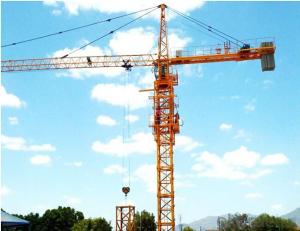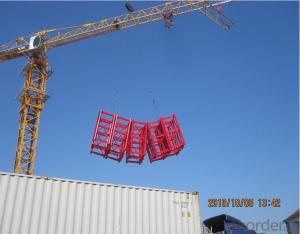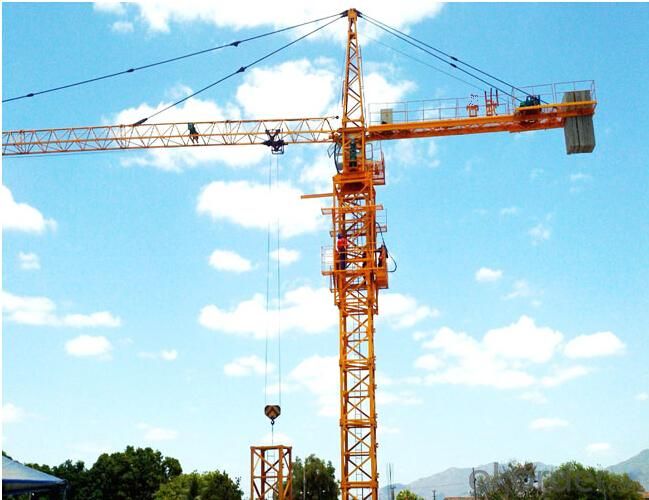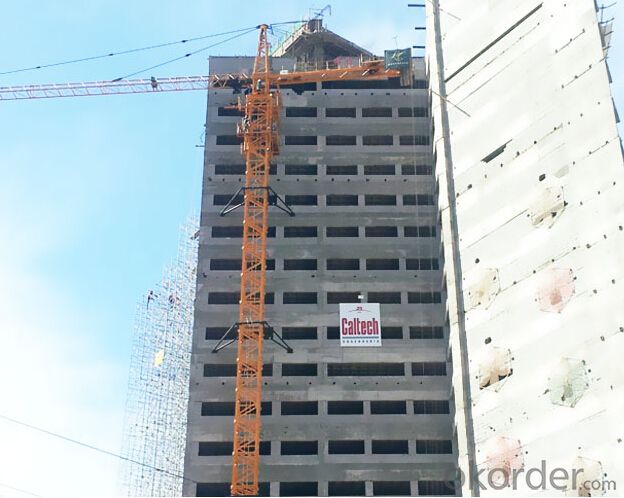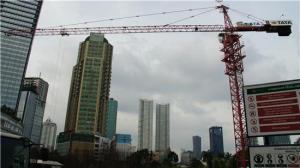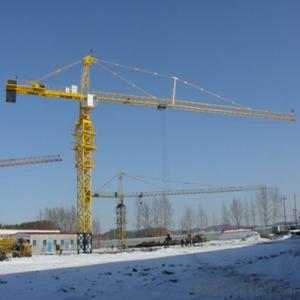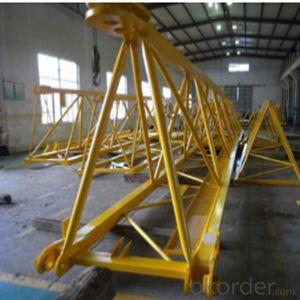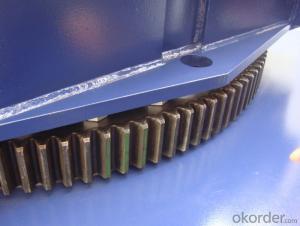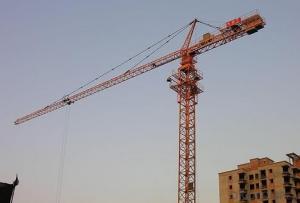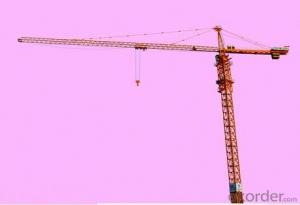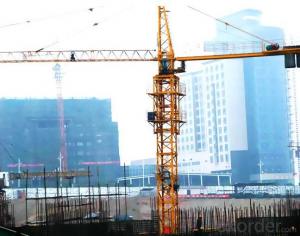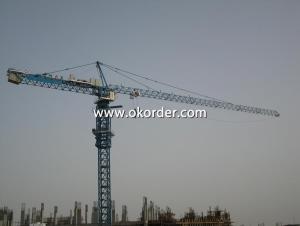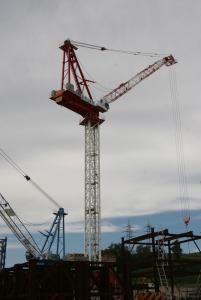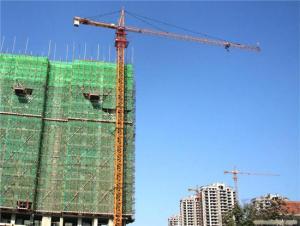Topkit Tower Crane TC5613 with Jib legth of 56M
- Loading Port:
- Shanghai
- Payment Terms:
- TT OR LC
- Min Order Qty:
- 1 unit
- Supply Capability:
- 30 unit/month
OKorder Service Pledge
OKorder Financial Service
You Might Also Like
TC5613 Description
Condition: New
Rated Loading Capacity: 8t
Rated Lifting Moment: 800KN.m
Max. Lifting Load: 8t
Max. Lifting Height: 180m
Span: 56m
Place of Origin: Shandong, China (Mainland)
Model Number: TC5613
Certification: CE,ISO and GOST
Warranty: One year
After-sales Service Provided: Engineers available to service machinery overseas
Color: Yellow or optional
Electric components: Schneider
Tower section: Sheet-mounted type for tower crane for sale
Section dimension: 1.85*1.85*2.5m
Working environment temperature: -20℃~40℃
Raw materials: high quality manganese steel for 10t tower crane
Configurations: air conditioner, black box and remote control
Company type: factory for construction tower crane
TC5613 Features
1.Thirteen years of experience in supplying new self-erecting tower crane with Huiyou Brand.
2. Export to more than 20 countries with CE/ISO/GOST Certificates.
3. Stationary/Travelling, external/ internal climbing tower crane
4. Impeller blasting/rust protection paint
5. Advanced painting process
TC5613 Specifications
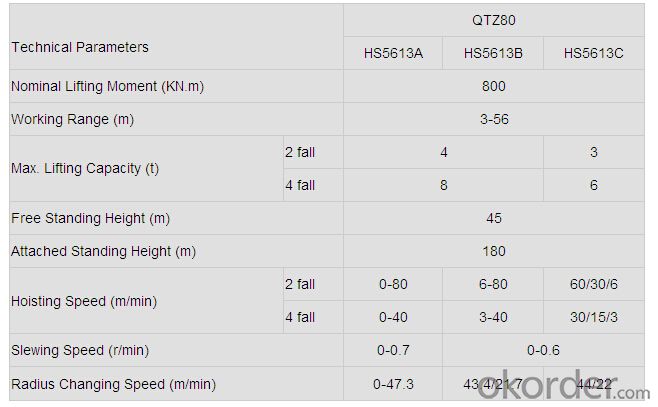
TC5613 Pictures
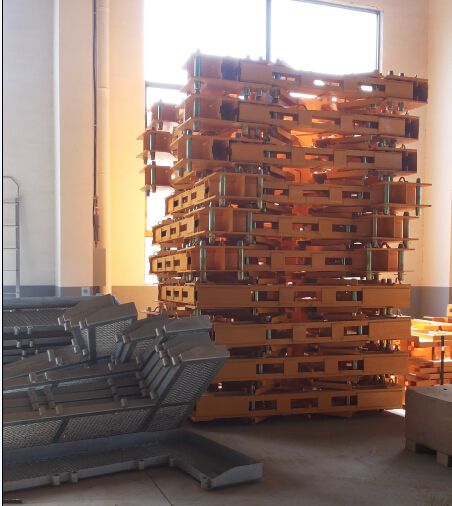
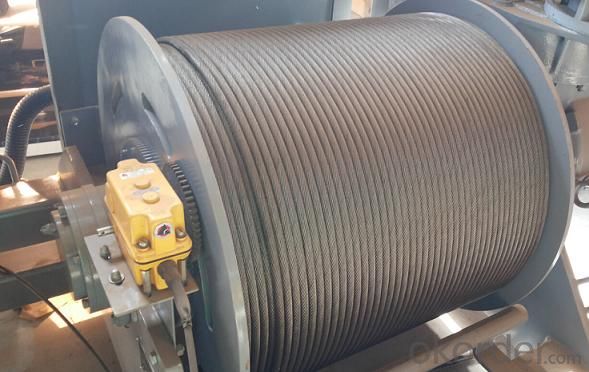
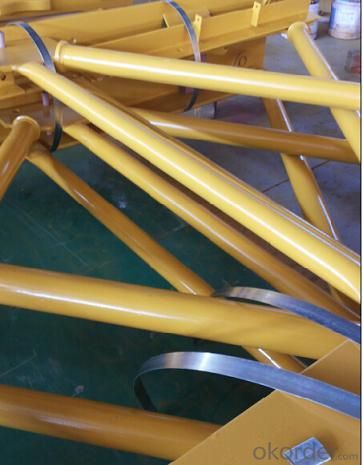

TC5613 FAQ
Q: What is tower crane?
A: Tower crane is a modern form of balance crane that consist of the same basic parts. Fixed to the ground on a concrete foundation (and sometimes attached to the sides of structures as well), tower cranes often give the best combination of height and lifting capacity and are used in the construction site.
Q: What is the meaning of the tower crane’s code?
A: Take TC5013 for example, the first two letters “TC” means Tower Crane, “50” means jib length is 50 meter, and the last two letter “13” means the tip load is :1.3 ton.
- Q: A crane operator must ensure that the load is within load chart ratings for _________ and the __________ of the crane.A. Boom length; CenterpointB. Boom length; Load RadiusC. Center Point, Load RadiusD. Center of Gravity; Load Radius
- B. The load radius is the horizontal distance from the center of rotation of the crane to the center of gravity of the load being lifted. The load radius is a critical consideration when determining what size crane is required for most lifts. There is generally a chart that tells what that machine will lift at any boom length,
- Q: I understand the Crane stances and know there are more than one. I am referring to the single leg crane stance. I also know that stances are only used briefly. But I am curious, does this stance have any bunkai applications? Or is it only useful against dodging a kick or preparing to kick?
- Great question. This is one of those stances that I believe can be more static in nature. I think this stance, as Kokoro points out, is a great example of a lying-on-the-floor technique without actually having to lie on the floor. There are 3 kinds of crane stances, that I'me aware of: 1) the left foot is placed behind the right knee and the left foot's shin is perpendicular to the floor 2) the left foot is placed next to right knee and the left foot's shin is perpendicular to the floor 3) the left foot is placed next to right knee and the left foot's shin is ANGLED (sticks out to the left) to the floor in method 1), the application can represent a bind, hook, or pull toward you, of opponet's knee/shin while standing or lying down. in method 2), the there are a couple of applications: 2a) it is a on-the-floor position where you are mounted; your knee up represents keeping the distance open between you and opponent. 2b) it is a chamber of sorts to a jumping front snap kick (some call this a crane kick, which was a question that was asked about this a day or two ago) - and Shadam mentions this again in this question 2c) it is a check or block of a kick or weapon, as Liondancer mentions. in method 3), the application represents that your opponent is kicked to the inside of the knee: either to disable or to sweep.
- Q: I want to win a watch from a skill crane at Dave and Buster's and I need some tips.
- www.okorder /
- Q: ok so i have to us my phone so just give me instructions no links no youtube videos cause my phone cant support them and my phone may not be able to load some of the links
- You are asking for a lot but I have seen you request this a number of times, so I will do it...a sucker born. 1. Valley fold the paper in half so it makes a triangle. With the long side held away from you, valley fold the triangle in half again. 2. Lift the top triangle and valley fold it so that its top point meets its bottom point. Unfold the crease you have just made. Put your fingers inside the top triangle, open it up, and flatten it so it forms a square. Turn the paper over and fold and flatten the remaining triangle in the same way. 3. Make sure that the open ends of the paper are pointing down. Valley fold the top layer of both sides in to meet the centre crease. You will now have a kite shape. 4. Valley fold the top point of the kite down and crease well. Unfold the crease you have just made. 5. Open the sides of the kite by unfolding the flaps you made in Step 3. Lift the top layer of the kite's bottom point up so the paper bends at the crease you made in Step 4. Push the outside edges of the paper in to meet the centre line. Then flatten the figure so that you have a long diamond shape. 6. Turn the figure over and fold a kite shape on the remaining side as in Step 3. Repeat Steps 4 and 5 on this side. You will now have a two-sided long diamond. The bottom half of the diamond is split in two. 7. Valley fold the top layer of both bottom edges in to meet in the middle. Turn the figure over and repeat on the other side. 8. To make the crane's neck and tail, valley fold each half of the bottom section out to the sides. Crease well. 9. Unfold the right crease you just made and make an inside reverse fold. Repeat this step on the left side. 10.To form the head, fold down the end of the neck. Unfold this crease and inside reverse fold the head. 11.Hold one of the crane's wings in each hand. Blow hard into the opening on the underside of the figure and gently separate your hands. You crane will puff up and be ready to hang.
- Q: I need to know how Stephen Crane came up with writing the Red Badge of Courage. I need examples of his life experiences that he had and then he put them in the Red Badge of Courage.
- In March 1893, while spending hours lounging in his friend Corwin Knapp Linson's studio while having his portrait painted, Crane became fascinated with old Civil War issues of the Century published between 1884 and 1887. Largely devoted to famous battles and military leaders, the writing was dry and lifeless and Crane, frustrated, said to Linson, I wonder that some of those fellows don't tell how they felt in those scraps. They spout enough of what they did, but they're as emotionless as rocks. Crane returned to these magazines during subsequent visits to Linson's studio and eventually the idea of writing a war novel overtook him. He would later state that he had been unconsciously working the detail of the story out through most of his boyhood and had imagined war stories ever since he was out of knickerbockers. This novel, which he believed would make him famous, would ultimately become The Red Badge of Courage. From the beginning, Crane wished to show what it felt like to be in a war by writing a psychological portrayal of fear. Conceiving his story from the point of view of a young private who is at first filled with boyish dreams of the glory of war and then quickly becomes disillusioned by war's reality, Crane borrowed the private's surname, Fleming, from his sister-in-law's maiden name. Crane would later tell Hamlin Garland that the first words and paragraphs came to him with every word in place, every comma, every period fixed.
- Q: What does "automatic tower crane" mean less than 100 tons per metre?
- When you are working on this crane, the weight between the weight and the weight to the horizontal distance of the crane Center shall not be greater than 100 tons.For example, if the weight and crane center level distance is 10 meters, the maximum weight is 10 tons; if it is 20 meters, the maximum lifting weight is 5 tons; if it is 40 meters, the maximum lifting weight is 2.5 tons.
- Q: I remember it was either an anime/manga or a movie but a boy or girl makes a thousand paper cranes for someone who is dying (possible their mother). I'm pretty sure it's an anime. It's not the story about the little girl with leukemia, I know that. I also remember the little girl/boy putting them on the edge of the bed or something? It's not much to go by but if you can help me I would be eternally grateful.
- Sadako and the 1000 paper cranes by Eleanor Coerr; the anime theatrical.
- Q: does wing chun and karate come from the same white crane style of wushu/kung fu?
- The correct answer is given by Daoshi.
- Q: The car weights approx 900 kg.Thank you xx
- Gravity acts downwards, force = mass x acceleration. Crane acts upwards at same force. As the crane starts to lift the car there is upwards acceleration that causes more force to be generated for a moment.
- Q: How to crane fly out of your room?
- Trap it in a jar and release it outside,they are easy enough to catch. I catch them and feed them to my spiders.
Send your message to us
Topkit Tower Crane TC5613 with Jib legth of 56M
- Loading Port:
- Shanghai
- Payment Terms:
- TT OR LC
- Min Order Qty:
- 1 unit
- Supply Capability:
- 30 unit/month
OKorder Service Pledge
OKorder Financial Service
Similar products
Hot products
Hot Searches
Related keywords
